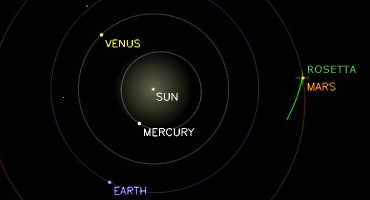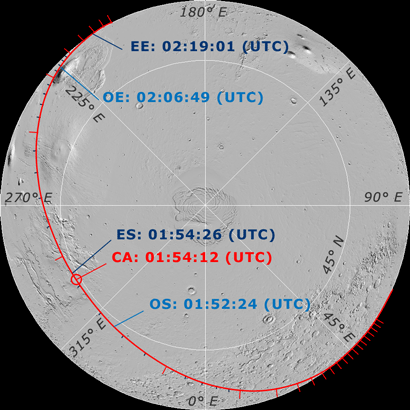Rosetta Mars Swing-by
23 February 2007
The Rosetta swing-by of Mars is the second of four gravity assist manoeuvres that are required to place Rosetta on course for its final destination: comet 67P/Churyumov-Gerasimenko. The closest approach of the swing-by will take place at 01:54 UT, 25 February 2007, when the spacecraft will pass 250 km above the surface of Mars.Updates on the progress of the flyby can be found on the ESA Rosetta Swing-by site.
 |
|
Relative positions of planets of the inner solar system and Rosetta at the time of closest approach. |
|
||||||||||
|
Dates of Assist Manoeuvres |
The Mars swing-by has been setup with two Deep Space Manoeuvres on 29 September 2006 and 13 November 2006 and a Trajectory Control Manouevre on 9 February 2007 to accurately set Rosetta on the required swing-by path (see related status reports on the right hand side).
Mars Swing-by Details
| Event |
Time (UT) |
| Occultation Start | 01:52:24 |
| Closest Approach | 01:54:12 |
| Eclipse Start | 01:54:25 |
| Occultation End | 02:06:50 |
| Eclipse End | 02:19:10 |
The time of closest approach is at approximately 01:54 UT, when Rosetta is only 250 km above the Martian surface and traveling at a speed of over 36 000 kmh-1 relative to Mars. The swing-by takes Rosetta over Mars's northern hemisphere, with the point of closest approach of a surface position of 298.2° E and 43.5° N.
During the swing-by, Rosetta will pass behind Mars, as seen from Earth, resulting in a loss of communication for a period of 15 minutes, starting 2 minutes before closest approach.
In addition, Rosetta will pass through the shadow cast by Mars for a period of 25 minutes and go into eclipse. For this reason the spacecraft instruments are not active at closest approach - except for the Radio Science experiment. Power will be provided by the spacecraft's batteries.
 |
|
North polar view of Mars with ground trace for the swing-by |
Planned Science Activities
Mars
Between 8 hours and 4 hours prior to closest approach, the orbiter instruments will perform targeted observations of the Martian surface and the two moons of Mars, Phobos and Deimos.
Because Philae runs off its own separate power supply it is possible to have some of these instruments active during the eclipse phase. At closest approach the ROMAP and CIVA instruments will be operated. ROMAP (Rosetta Lander Magnetometer and Plasma Monitor) will take magnetometric measurements from 12 hours before to 12 hours after closest approach. CIVA (Comet Nucleus Infrared and Visible Analyser) will perform imaging of Mars.
| Activity | Instrument | |
| Mars spectroscopy and imaging of surface and atmosphere | OSIRIS | Orbiter |
| ALICE | Orbiter | |
| VIRTIS | Orbiter | |
| CIVA | Lander Philae | |
| Investigating the interaction of Mars with the solar wind | Rosetta Plasma experiment | Orbiter |
| ROMAP | Lander Philae | |
| OSIRIS | Orbiter | |
| Phobos and Deimos imaging | OSIRIS | Orbiter |
| Searching for anomalous accelerations during the swing-by |
Radio Science experiment |
Orbiter |
| Investigating the Mars radiation environment |
Radiation Monitor |
Orbiter |
Jupiter
On 27 February, only a few days after Rosetta's closest approach to Mars, NASA's New Horizon spacecraft will perform a swing by of Jupiter and afterwards will fly along the planet's magnetotail for about 100 days.
Due to Sun illumination conditions, Rosetta will be able to observe Jupiter for 4 hours on 28 February and continuously after 1 March. Rosetta will make Jupiter observations with the ALICE, VIRTIS and OSIRIS instruments.
Pioneer Anomaly
First observed with the NASA Pioneer spacecraft, the anomaly represents a deviation in the expected change in spacecraft velocity and trajectory against observations. Scientists are not certain if the anomaly is caused by an unknown physical process, or if it is simply down to the uncertainties in measurements and analytical calculations. A test will be carried out using a MASER signal sent from the ground based tracking stations.


